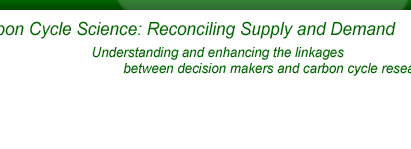 |
|
|
|
 |
|||||
|
|
|
|
|||||||
 |
|
|
|
|
|||||
 |
|||||||||
 |
|
|
|
|
Carbon Cycle Science Supply Side Sector: Sequestration Technologies
The debate on what to do about global warming usually centers around two options: mitigation and adaptation. A third, less frequently discussed option also exists: sequestration of CO2. The basic idea of carbon sequestration is to remove CO2 from the atmosphere, or prevent it from getting there in the first place, and then store it elsewhere. While there are a wide variety of sequestration options that are currently being researched, the Department of Energy’s Office of Fossil Energy has identified three basic requirements for carbon sequestration to be successful:
- Be effective and cost-competitive
- Provide stable, long term storage
- Be environmentally benign
What follows is a sample of the various sequestration options and relevant research and links.
No-till or Low-till agriculture
Agriculture emits CO2 when farmers till their fields and expose organic matter in the soil to the air. The soil organic matter, mainly carbon, then decomposes and is converted into atmospheric CO2. Reducing or eliminating tillage can prevent soil organic matter loss and hence decrease agricultural emissions. Agricultural soils could be turned into a short-term sink for carbon dioxide under no-till methods. The IPCC believes that cropland sequestration could total 40-80Gt C in the next 50 to 100 years.
Soil Conservation Practices
Practices designed to reduce soil erosion from agricultural lands can contribute to efforts to increase soil carbon, and hence to sequester atmospheric carbon. Some such practices include planting cover crops to eliminate vare fallow periods, planting hedges or grass strips as wind breaks, reducing week control in areas of high erosion, terracing , and planting perpendicular to the slope of the field and /or the prevailing wind direction (Hedger et al. 1997).
Cropland Retirement
Numerous studies have detailed the vast amounts of carbon lost when forests and grasslands are converted to agricultural land. Retiring land from crop production and reestablishing perennial vegetation can go a long way to recover this lost carbon and produce a temporary (years to decades) sink for CO2. This retirement can take several forms: abandonment of farms; allowing nature to take its course; deliberate efforts to reestablish forests or grassland through active land management; or temporary set-asides.
CO2 Separation and Capture Technologies
Chemical Absorption of CO2 using an amine solvent (Scrubbing)
Chemical absorption using amine or carbonate solvents, also known as scrubbing, is the most well established method of carbon capture. Virtually every commercial CO2 capture plant in operation uses this process. After removing impurities from the flue gas, such as NOx, SOx and hydrocarbons, the gas is passed through an absorption column in which the amine reacts with the CO2 and selectively absorbs it from the gas stream. The CO2-rich amine is then heated, where the CO2 is released from the amine as nearly pure gas.
Chemical absorption of CO2 using alternative sorbents
The process of absorption using alternative sorbents is similar to that of using amine solvents, but tends to absorb more CO2 with lower energy, material or space demands. Various sorbents have been tested such as aqueous potassium carbonate combined with the chemical piperazine; magnesium hydroxide; lithium silicate ceramic; and a nickel-based sorbent.
Adsorption
Adsorption differs from absorption in that one substance is made to adhere or ‘stick’ to another, rather than being incorporated into the other substance. Adsorption is therefore based on physical, rather than chemical, interactions between materials.
Gas separation and absorption membranes
Gas separation membranes rely on differences in physical or chemical interactions between the different substances in a gas mixture and a membrane material that cause on e component to move through the membrane faster than another. A gas separation membrane would allow carbon dioxide gas to pass through while excluding the other parts of the flue gas emitted industrial or power plants (IEA 1993). Gas absorption membranes, on the other hand, simply function as a contact point between flue gas and an absorbing liquid, such as an amine-based solution.
Cryogenic separation
In a cryogenic separation system, CO2 is physically separated from other gases by condensing it into a liquid form at an extremely low temperature. The liquid CO2 produced would immediately ready for transport to the disposal site.
Iron Fertilization of Marine Phytoplankton
Photosynthetic carbon fixation by marine phytoplankton creates 45 Gt of organic carbon per year (Falkowski et al. 1998). While much of this is eaten by sea animals near the surface and ultimately ends up being recycled into the atmosphere, some eventually rains down into the deep ocean as waste and dead organisms. Bacteria feed on this organic carbon and produce CO2, which dissolves while the rest of the detritus ends on the sea floor. The availability of nutrients, particularly iron, is the limiting factor on phytoplankton growth in large parts of the ocean. By depositing iron into the ocean, it may be possible to stimulate phytoplankton growth and hence encourage an increased biological uptake of carbon dioxide from the atmosphere, eventually depositing the carbon in the deep oceans for decades or centuries.
Direct Oceanic Injection of CO2
CO2 separated from point sources can be placed directly into the oceans. Methods include using:
- Droplet plume: Liquid CO2 is injected at a depth lower than 1000m from a manifold lying on the ocean bottom. Since carbon dioxide is less dense than seawater at that pressure and temperature, it would rise upwards, forming a rising droplet plume.
- Dense plume: Is a more concentrated, denser CO2-seawater mixture created at a depth of 500-1000 m. As it sinks, a bottom current is formed, carrying the mixture into the deeper ocean.
- Towed pipe: Is similar to the droplet plume, but the CO2 is discharged from a long pipe that is towed behind a ship.
Dry ice: Solid CO2 is released at the ocean’s surface by a conventional ship. - CO2 Lake: Pipes running along the ocean bottom would pump liquid CO2 into a seafloor depression, creating a stable ‘deep lake’ at a depth of 3000-4000 meters.
Enhanced Oil Recovery (EOR)
EOR is the practice of injecting CO2 gas into depleted underground oil reservoirs in order to displace and recover more oil than would have been possible otherwise. If the pressure is high enough in these formations, the CO2 and oil become completely miscible, leading to highly efficient oil recovery. CO2 flooding of oil fields can actually increase the yield of oil production.
Enhanced Gas Recovery of Coalbed Methane
Methane gas is adsorbed in large quantities onto the surface of coal in large, unmineable coal seams. The current practice for recovering coal bed methane is to depressurize the bed by pumping water out of the reservoir, but another possibility is to inject CO2 gas into the bed. Chemical tests have shown that CO2 adsorbs onto coal twice as much as methane, and it therefore has the potential to efficiently displace methane and remain sequestered in the coalbed.
Injection in Deep Saline Aquifers
Saline aquifers are underground layers fo very porous, permeable sediment filled with brackish, non-potable water. In most instances, such formations are located below freshwater aquifers, with a laywer fo impermeable rock separating the two (Herzong et al. (1997), and if the temperature and pressure of the aquifer are within certain limits, it can be used for carbon sequestration (Hovorka et al. 2000). CO2 is pumped through wells directly into the aquifer. Some of the CO2 will dissolve and react with other dissolved salts to form carbonate minerals that will become permanently fixed as a rock (Rosenbauer 2002), while the rest will remain in the water of the aquifer.
Mineral Carbonation
At point sources, separated CO2 can either be piped somewhere else to be sequestered or converted to another form through chemical processes. Through mineral carbonation, naturally occurring minerals containing magnesium or calcium are reacted with CO2 to form other minerals known as carbonates. The goal of artificial mineral carbonation is to speed up the reaction. CO2 is mixed with slurry of water and reactants, heated and compressed. The product is a stable rock in which CO2 has been chemically transformed and that will remain stable over geologic time periods.
Landfill Gas Recovery (LGR) with CO2 Sequestration
Landfills are a major source of greenhouse gases such as methane and CO2. Landfill gases can be captured and through a cryogenic process, CO2 can be separated from methane. The methane, that would normally escape to the atmosphere, can be used to fuel power plants or be used in other applications. The CO2 can then be sequestered in liquid form.
Other methods of sequestration
Some methods include growing biofuel crops, shifting production to crops that absorb more atmospheric CO2, active forest management to enhance carbon uptakes, and biologically based capture methods.